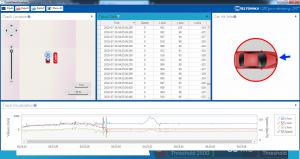Template:FMB Accelerometer Features settings: Difference between revisions
Danielekrau (talk | contribs) No edit summary |
Small improvements |
||
| Line 3: | Line 3: | ||
Accelerometer auto calibration functionality has one purpose - determine how FMB device | Accelerometer auto calibration functionality has one purpose - determine how FMB device | ||
is mounted in a vehicle. After the calibration process ''eco driving'' functionality becomes active | is mounted in a vehicle. After the calibration process ''eco driving'' functionality becomes active | ||
and calibration data will be used to determine harsh acceleration, braking and cornering events.<br/> | and calibration data will be used to determine harsh acceleration, braking and cornering events.<br /> | ||
There are two conditions when auto calibration takes place:<br/> | There are two conditions when auto calibration takes place:<br /> | ||
* If on device startup no calibration was detected; | |||
* If the device receives an SMS/GPRS message with ''auto_calibrate:set'' text.<br/> | *If on device startup no calibration was detected; | ||
*If the device receives an SMS/GPRS message with ''auto_calibrate:set'' text.<br /> | |||
After functionality has started FMB device periodically checks current appliance GNSS, | After functionality has started FMB device periodically checks current appliance GNSS, | ||
ignition and movement source parameters and if the conditions match:<br/> | ignition and movement source parameters and if the conditions match:<br /> | ||
* position fix got; | |||
* GNSS speed is zero; | *position fix got; | ||
* ignition is ON; | *GNSS speed is zero; | ||
* first calibration vector was not saved yet;<br/> | *ignition is ON; | ||
*first calibration vector was not saved yet;<br /> | |||
Then first vector is taken. Saved vector will be considered as ground vector and it will be | Then first vector is taken. Saved vector will be considered as ground vector and it will be | ||
used at further calibration calculations.<br/> | used at further calibration calculations.<br /> | ||
''Note: When FMB device saves first ground vector vehicle must be parked on flat ground''. | ''Note: When FMB device saves first ground vector vehicle must be parked on flat ground''. | ||
Crooked vector may have an impact on further calculations.<br/> | Crooked vector may have an impact on further calculations.<br /> | ||
Afterwards first ground vector was taken, device analyses conditions:<br/> | Afterwards first ground vector was taken, device analyses conditions:<br /> | ||
* position fix got; | |||
* GNSS speed is at least 20 km/h; | *position fix got; | ||
* ignition is ON; | *GNSS speed is at least 20 km/h; | ||
* second vector was not saved yet; | *ignition is ON; | ||
* vehicle driving in the same direction with 5⁰ tolerance; | *second vector was not saved yet; | ||
* vehicle speed increase by 7km/h within 1 second.<br/> | *vehicle driving in the same direction with 5⁰ tolerance; | ||
*vehicle speed increase by 7km/h within 1 second.<br /> | |||
For next vector. Second vector will be taken if all conditions match. Immediately after | For next vector. Second vector will be taken if all conditions match. Immediately after | ||
second vector is received, it will be multiplied by first (ground) vector, the result of these | second vector is received, it will be multiplied by first (ground) vector, the result of these | ||
| Line 29: | Line 35: | ||
same vector multiplication method, device front, left side will be calculated. At this point | same vector multiplication method, device front, left side will be calculated. At this point | ||
calibration is successfully ended as indication device sends an SMS/GPRS message with | calibration is successfully ended as indication device sends an SMS/GPRS message with | ||
''Device is calibrated, to recalibrate send:auto_calibrate:set''.<br/> | ''Device is calibrated, to recalibrate send:auto_calibrate:set''.<br /> | ||
''Note: SMS/GPRS message will be sent only if auto calibration functionality was triggered by | ''Note: SMS/GPRS message will be sent only if auto calibration functionality was triggered by'' | ||
SMS/GPRS message''.<br/> | SMS/GPRS message''.<br />'' | ||
For user convenience in case auto calibration functionality fails then notification message | For user convenience in case auto calibration functionality fails then notification message | ||
will be sent. For exact messages, check algorithm section.<br/> | will be sent. For exact messages, check algorithm section.<br /> | ||
''Note: SMS/GPRS message will be sent only if auto calibration functionality was triggered by | ''Note: SMS/GPRS message will be sent only if auto calibration functionality was triggered by'' | ||
SMS/GPRS message''.<br/> | SMS/GPRS message''.<br />'' | ||
To get current calibration status ''auto_calibrate:get'' SMS/GPRS command must be sent to | To get current calibration status ''auto_calibrate:get'' SMS/GPRS command must be sent to | ||
the device. If device is calibrated it will respond with ''Calibration state: calibrated'' or otherwise | the device. If device is calibrated it will respond with ''Calibration state: calibrated'' or otherwise | ||
''Calibration state: not calibrated''. Also this command returns saved Ground and Side vectors.<br/> | ''Calibration state: not calibrated''. Also this command returns saved Ground and Side vectors.<br /> | ||
After every TRIP START event, device starts shadow calibration. This type of calibration is | After every TRIP START event, device starts shadow calibration. This type of calibration is | ||
running in parallel with already saved vectors (this means that vectors does not reset until | running in parallel with already saved vectors (this means that vectors does not reset until | ||
shadow calibration have both new vectors). After shadow calibration is done, device updates the | shadow calibration have both new vectors). After shadow calibration is done, device updates the | ||
vector values to the new ones. There are two conditions when shadow calibration does not run | vector values to the new ones. There are two conditions when shadow calibration does not run | ||
at TRIP start event:<br/> | at TRIP start event:<br /> | ||
* Normal calibration is still running. | |||
* Shadow calibration is still running from previous TRIP event.<br/> | *Normal calibration is still running. | ||
To take ground vector these conditions should be met:<br/> | *Shadow calibration is still running from previous TRIP event.<br /> | ||
* Ignition is ON | |||
* Device got GPS FIX | To take ground vector these conditions should be met:<br /> | ||
* Vehicle speed = 0km/h<br/> | |||
Device will check these conditions every 1sec until they will pass.<br/> | *Ignition is ON | ||
To take side vector these conditions should be met:<br/> | *Device got GPS FIX | ||
* Vehicle speed >= 20km/h | *Vehicle speed = 0km/h<br /> | ||
* Device got GPS FIX | |||
* Ignition is ON | Device will check these conditions every 1sec until they will pass.<br /> | ||
* Device angle does not change more than 5 degrees in past 1 sec | To take side vector these conditions should be met:<br /> | ||
* Speed need to increase by 7km/h in 1s period.<br/> | |||
Device will check these conditions every 1 sec until they will pass.<br/> | *Vehicle speed >= 20km/h | ||
*Device got GPS FIX | |||
*Ignition is ON | |||
*Device angle does not change more than 5 degrees in past 1 sec | |||
*Speed need to increase by 7km/h in 1s period.<br /> | |||
Device will check these conditions every 1 sec until they will pass.<br /> | |||
==Excessive Idling== | ==Excessive Idling== | ||
| Line 88: | Line 100: | ||
''Towing Detection'' feature helps to inform the driver about unexpected car movement when it was parked. {{{model|FMB1YX}}} generates an event when car is being towed or lifted, for example, in a case of vehicle evacuation. {{{model|FMB1YX}}} activates towing function when following conditions are met: | ''Towing Detection'' feature helps to inform the driver about unexpected car movement when it was parked. {{{model|FMB1YX}}} generates an event when car is being towed or lifted, for example, in a case of vehicle evacuation. {{{model|FMB1YX}}} activates towing function when following conditions are met: | ||
# Ignition (configured Ignition Source) is OFF. | |||
# ''Activation Timeout'' is reached. | #Ignition (configured Ignition Source) is OFF. | ||
#''Activation Timeout'' is reached. | |||
When towing function is engaged {{{model|FMB1YX}}} monitors accelerometer data. If acceleration ''Threshold'' or ''Angle'' reach configured values for a configured ''Duration'', and Ignition is still OFF for a period of time that is longer than ''Event Timeout'', then an event is generated. When configured, ''Make Call To'' and ''Send SMS To'' functions make a call or send an SMS to a predefined phone number. Towing function will be reactivated after {{{model|FMB1YX}}} detects a change of Ignition state from ON to OFF. | When towing function is engaged {{{model|FMB1YX}}} monitors accelerometer data. If acceleration ''Threshold'' or ''Angle'' reach configured values for a configured ''Duration'', and Ignition is still OFF for a period of time that is longer than ''Event Timeout'', then an event is generated. When configured, ''Make Call To'' and ''Send SMS To'' functions make a call or send an SMS to a predefined phone number. Towing function will be reactivated after {{{model|FMB1YX}}} detects a change of Ignition state from ON to OFF. | ||
<br><br><br><br><br><br><br> | <br><br><br><br><br><br><br> | ||
| Line 97: | Line 111: | ||
[[File:Crash Detection cfg.PNG|right]] | [[File:Crash Detection cfg.PNG|right]] | ||
If ''Crash Detection'' is enabled, it monitors acceleration on each axis which helps to detect an accident. ''Threshold'' and ''Duration'' values are set depending on the impact magnitude that is required to be detected. {{{model|FMT100}}} can detect events ranging between a slight tapping on the device and a severe accident.<br/> | If ''Crash Detection'' is enabled, it monitors acceleration on each axis which helps to detect an accident. ''Threshold'' and ''Duration'' values are set depending on the impact magnitude that is required to be detected. {{{model|FMT100}}} can detect events ranging between a slight tapping on the device and a severe accident.<br /> | ||
If ''Crash Trace'' is disabled only one eventual crash record will be generated when ''Duration (ms)'' and ''Threshold (mg)'' values are exceeded. <br/> | If ''Crash Trace'' is disabled only one eventual crash record will be generated when ''Duration (ms)'' and ''Threshold (mg)'' values are exceeded. <br /> | ||
If ''Crash Trace'' is enabled, {{{model|FMT100}}} will collect crash trace data with frequency defined by ''Trace ODR (Hz)'' parameter. Acceleration, GNSS and IO data monitoring duration during the crash event is defined by these parameters: | If ''Crash Trace'' is enabled, {{{model|FMT100}}} will collect crash trace data with frequency defined by ''Trace ODR (Hz)'' parameter. Acceleration, GNSS and IO data monitoring duration during the crash event is defined by these parameters: <br /> | ||
There are three configurable Crash Trace modes:<br/> | *''Accel duration (s)''. Acceleration data duration can be set for up to 15 seconds before crash event and 15 seconds after; <br /> | ||
*''GNSS duration (s)''. GNSS data duration can be set for up to 30 seconds before crash event and 30 seconds after. <br /> | |||
*''IO duration (s)''. IO data duration can be set for up to 30 seconds before crash event and 30 seconds after. <br /> | |||
There are three configurable Crash Trace modes:<br /> | |||
'''Trace Full''' | '''Trace Full''' | ||
* Data tracked: all GNSS and acceleration data <br/> | |||
*Data tracked: all GNSS and acceleration data <br /> | |||
'''Trace Full with IO's''' | '''Trace Full with IO's''' | ||
* Data tracked: all GNSS and acceleration data with IO's, configured in I/O settings as "Crash" parameter (see picture below) <br/> | |||
*Data tracked: all GNSS and acceleration data with IO's, configured in I/O settings as "Crash" parameter (see picture below) <br /> | |||
[[File:Crash event input.png|thumb|none]] | [[File:Crash event input.png|thumb|none]] | ||
'''Trace Changes''' | '''Trace Changes''' | ||
NOTE: with Crash Trace mode enabled, it is recommended to use ''Codec 8 Extended'' Data Protocol. This helps to optimize crash trace data sending from device to server. | *Data tracked: GNSS and acceleration data, when acceleration values are changed by more then 50mG <br /><br /> | ||
NOTE: with Crash Trace mode enabled, it is recommended to use ''[[Codec#Codec 8 Extended|Codec 8 Extended]]'' Data Protocol. This helps to optimize crash trace data sending from device to server. | |||
[[File:Codec 8 Extended setting.png|thumb|none]] | [[File:Codec 8 Extended setting.png|thumb|none]] | ||
Each record will have accurate timestamps in milliseconds. <br/> | Each record will have accurate timestamps in milliseconds. <br /> | ||
| Line 127: | Line 146: | ||
==Crash Data Visualisation== | ==Crash Data Visualisation== | ||
With Teltonika ''CrashDataVisualizer'' tool you can analyze crash trace data visually: determine impact to vehicle direction, view crash trace on the map, also see the change of mG and speed values during crash time period. CrashDataVisualizer is dedicated to work with TAVL application, it means that only crash trace log files exported from TAVL is compatible. To have ability to export crash trace log files, device must be configured to send data by Codec8E. | With Teltonika ''CrashDataVisualizer'' tool you can analyze crash trace data visually: determine impact to vehicle direction, view crash trace on the map, also see the change of mG and speed values during crash time period. CrashDataVisualizer is dedicated to work with TAVL application, it means that only crash trace log files exported from TAVL is compatible. To have ability to export crash trace log files, device must be configured to send data by [[Codec#Codec 8 Extended|Codec8E]]. | ||
'''To start using CrashDataVisualizer'''<br /> | '''To start using CrashDataVisualizer'''<br /> | ||
| Line 145: | Line 164: | ||
2. Set the date of event<br /> | 2. Set the date of event<br /> | ||
3. Select the object you want to analyze<br /> | 3. Select the object you want to analyze<br /> | ||
4. Press "Crashes" button<br/><br/><br/><br/><br/><br/><br/><br/> | 4. Press "Crashes" button<br /><br /><br /><br /><br /><br /><br /><br /> | ||
Crash event list window will show up. Press Download icon and save crash event file (.JSON).<br /> | Crash event list window will show up. Press Download icon and save crash event file (.JSON).<br /> | ||
[[File:JSON download.png|thumb|none]]<br /> | [[File:JSON download.png|thumb|none]]<br /> | ||
Revision as of 13:28, 3 December 2019
Accelerometer Calibration
Accelerometer auto calibration functionality has one purpose - determine how FMB device
is mounted in a vehicle. After the calibration process eco driving functionality becomes active
and calibration data will be used to determine harsh acceleration, braking and cornering events.
There are two conditions when auto calibration takes place:
- If on device startup no calibration was detected;
- If the device receives an SMS/GPRS message with auto_calibrate:set text.
After functionality has started FMB device periodically checks current appliance GNSS,
ignition and movement source parameters and if the conditions match:
- position fix got;
- GNSS speed is zero;
- ignition is ON;
- first calibration vector was not saved yet;
Then first vector is taken. Saved vector will be considered as ground vector and it will be
used at further calibration calculations.
Note: When FMB device saves first ground vector vehicle must be parked on flat ground.
Crooked vector may have an impact on further calculations.
Afterwards first ground vector was taken, device analyses conditions:
- position fix got;
- GNSS speed is at least 20 km/h;
- ignition is ON;
- second vector was not saved yet;
- vehicle driving in the same direction with 5⁰ tolerance;
- vehicle speed increase by 7km/h within 1 second.
For next vector. Second vector will be taken if all conditions match. Immediately after
second vector is received, it will be multiplied by first (ground) vector, the result of these
vectors is vector multiplication cross product which is the right side of a car. By using
same vector multiplication method, device front, left side will be calculated. At this point
calibration is successfully ended as indication device sends an SMS/GPRS message with
Device is calibrated, to recalibrate send:auto_calibrate:set.
Note: SMS/GPRS message will be sent only if auto calibration functionality was triggered by
SMS/GPRS message.
For user convenience in case auto calibration functionality fails then notification message
will be sent. For exact messages, check algorithm section.
Note: SMS/GPRS message will be sent only if auto calibration functionality was triggered by
SMS/GPRS message.
To get current calibration status auto_calibrate:get SMS/GPRS command must be sent to
the device. If device is calibrated it will respond with Calibration state: calibrated or otherwise
Calibration state: not calibrated. Also this command returns saved Ground and Side vectors.
After every TRIP START event, device starts shadow calibration. This type of calibration is
running in parallel with already saved vectors (this means that vectors does not reset until
shadow calibration have both new vectors). After shadow calibration is done, device updates the
vector values to the new ones. There are two conditions when shadow calibration does not run
at TRIP start event:
- Normal calibration is still running.
- Shadow calibration is still running from previous TRIP event.
To take ground vector these conditions should be met:
- Ignition is ON
- Device got GPS FIX
- Vehicle speed = 0km/h
Device will check these conditions every 1sec until they will pass.
To take side vector these conditions should be met:
- Vehicle speed >= 20km/h
- Device got GPS FIX
- Ignition is ON
- Device angle does not change more than 5 degrees in past 1 sec
- Speed need to increase by 7km/h in 1s period.
Device will check these conditions every 1 sec until they will pass.
Excessive Idling
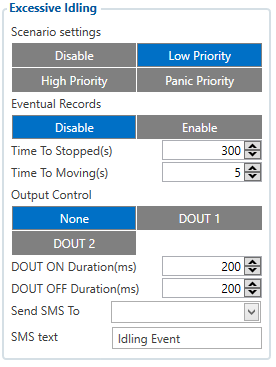
When vehicle stops for a specific amount of time the scenario is activated, a record will be generated and digital output status will be changed to 1 when configured. You can configure the time it takes to turn on this scenario (Time to Stopped). Scenario is activated until the vehicle starts moving (movement is detected only by the accelerometer) and keeps moving for an amount of time that is configured. You can configure the time it takes to turn off this scenario (Time to Moving)
info
Unplug Detection
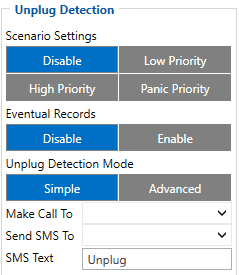
An event will be generated when FMB1YX is unplugged from external power or plugged back in again.
Scenario settings
- Disable - disable scenario.
- Low Priority - when low priority event is triggered, device makes additional record with indication of event cause.
- High Priority - module makes additional record with High priority flag and sends event packet immediately to the server by
GPRS.
- Panic Priority - triggers same actions as High priority, but if GPRS fails, it sends AVL packet using SMS mode if SMS is enabled in SMS Data Sending settings.
Eventual Records
- Disable - scenario status value is sent in each AVL record.
- Enable - scenario status value is sent only in eventual AVL records.
Unplug Detection mode
- Simple - unplug detection according to external voltage only. Is used in cars where power voltage is not dependent on ignition (recommended).
- Advanced - unplug detection according to external votage and accelerometer. Is used in cars where power voltage is disconnected when ignition is switched off.
Towing Detection
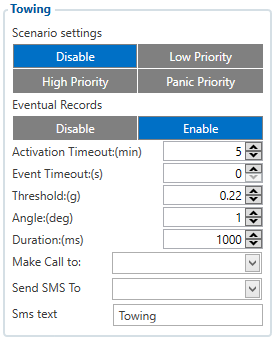
Towing Detection feature helps to inform the driver about unexpected car movement when it was parked. FMB1YX generates an event when car is being towed or lifted, for example, in a case of vehicle evacuation. FMB1YX activates towing function when following conditions are met:
- Ignition (configured Ignition Source) is OFF.
- Activation Timeout is reached.
When towing function is engaged FMB1YX monitors accelerometer data. If acceleration Threshold or Angle reach configured values for a configured Duration, and Ignition is still OFF for a period of time that is longer than Event Timeout, then an event is generated. When configured, Make Call To and Send SMS To functions make a call or send an SMS to a predefined phone number. Towing function will be reactivated after FMB1YX detects a change of Ignition state from ON to OFF.
Crash Detection
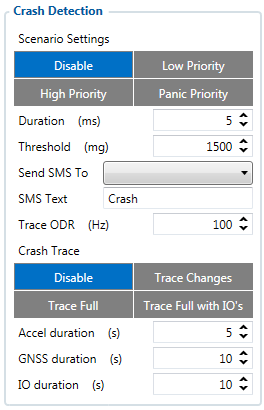
If Crash Detection is enabled, it monitors acceleration on each axis which helps to detect an accident. Threshold and Duration values are set depending on the impact magnitude that is required to be detected. FMT100 can detect events ranging between a slight tapping on the device and a severe accident.
If Crash Trace is disabled only one eventual crash record will be generated when Duration (ms) and Threshold (mg) values are exceeded.
If Crash Trace is enabled, FMT100 will collect crash trace data with frequency defined by Trace ODR (Hz) parameter. Acceleration, GNSS and IO data monitoring duration during the crash event is defined by these parameters:
- Accel duration (s). Acceleration data duration can be set for up to 15 seconds before crash event and 15 seconds after;
- GNSS duration (s). GNSS data duration can be set for up to 30 seconds before crash event and 30 seconds after.
- IO duration (s). IO data duration can be set for up to 30 seconds before crash event and 30 seconds after.
There are three configurable Crash Trace modes:
Trace Full
- Data tracked: all GNSS and acceleration data
Trace Full with IO's
- Data tracked: all GNSS and acceleration data with IO's, configured in I/O settings as "Crash" parameter (see picture below)

Trace Changes
- Data tracked: GNSS and acceleration data, when acceleration values are changed by more then 50mG
NOTE: with Crash Trace mode enabled, it is recommended to use Codec 8 Extended Data Protocol. This helps to optimize crash trace data sending from device to server.
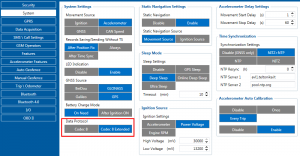
Each record will have accurate timestamps in milliseconds.
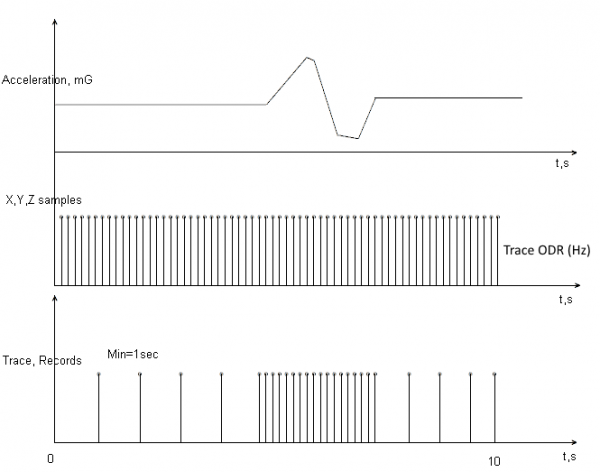
Crash Data Visualisation
With Teltonika CrashDataVisualizer tool you can analyze crash trace data visually: determine impact to vehicle direction, view crash trace on the map, also see the change of mG and speed values during crash time period. CrashDataVisualizer is dedicated to work with TAVL application, it means that only crash trace log files exported from TAVL is compatible. To have ability to export crash trace log files, device must be configured to send data by Codec8E.
To start using CrashDataVisualizer
Download and install TAVL (version 4.15.0.1 or later) + CrashDataVisualizer applications from here:
Link: https://teltonika.lt/client
Login: CrashDataVisualizer
Password: crasHdaTa789
To get crash data
Login to TAVL application (please contact your Sales manager for TAVL login information).
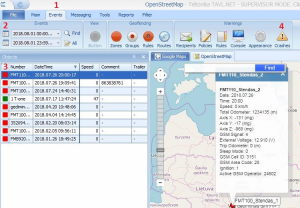
In TAVL application:
1. Go to Events
2. Set the date of event
3. Select the object you want to analyze
4. Press "Crashes" button
Crash event list window will show up. Press Download icon and save crash event file (.JSON).
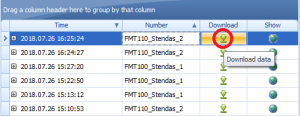
Viewing crash data in application
Open CrashDataVisualizer application. Drag and Drop or Browse crash data file (.JSON).
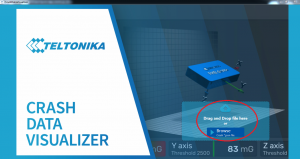
Use the Visualizer.
